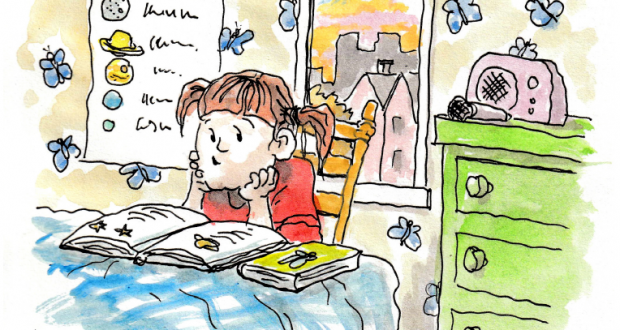Journey book reviewer Nick Mattiske recently illustrated a book for children, Thoughts That Feel So Big, written by Michelle Abel. Here, he tells Journey about the creation of the book and the big questions it asks.
Journey: Your book shows a young girl in her home and community, wondering about the world and how it all works, thinking big thoughts about God. Why did you and Michelle make the book?
Nick: My friend Michelle’s young niece was asking lots of really good questions, such as “Why can’t I see God?” Michelle’s sister—the girl’s mother—asked Michelle what to say to her and in the end, Michelle decided to write a book. Michelle works in international aid and is interested in things like indigenous knowledge and permaculture, so she’s interested in connections. Partly, she wanted the book to convey a wider sense of how community works, what makes a family, and how we are part of a wider world. She wanted to convey a positive picture of how God works through these things. We do see God, but in this secondary way. Like Jesus said, when you do things for others, you do them for him.
There’s also the message that some questions have no obvious answer.
Children want to know answers. Their curiosity is great. But sometimes adults don’t know. Honesty about this is good. I sense, too, that although the church sometimes wants to tie up the loose ends doctrinally, in the New Testament Jesus is saying that the work of caring is more important than “meaning of life” questions. Or rather, the caring helps with the “meaning of life” questions. It’s okay to recognise that God cares for us through others, and we can sit comfortably with the not knowing, in a philosophical sense. At the same time, we want to encourage the curiosity.
The illustrations set your character in a wider world of connections.
Michelle wanted to convey the idea of big and small connections through pictures of things in the natural world—of which we are a part—and through community. So, in a park you might see mushrooms, and there are hidden connections to the roots of a big tree. In the same park we might see a mother caring for a baby, while in a hospital nearby another family might be saying goodbye to someone who is dying. And then, if we expand out further, we are part of a community, and part of a whole world and beyond, and this is all pretty awe-inspiring. The illustrations are all linked, which helps us see these connections from different angles.
The book has some interesting ideas about how we see transcendence in the world, in a way kids can relate to.
Children have a more emotional response to the world, and it’s nice to recognise the good in that. Adults tend to bottle up and rationalise. Michelle has written in a great way about those parts of life that make us stop and just appreciate the beauty or be thankful about how we all work together, like seeing a sunset, or just the beauty of daily life. Incidentally, we are often given messages about the world being in competition, but here we are trying to show interconnectedness and cooperation, which we can see as gifts from God.
And of course, these things are fleeting.
Yes, we should appreciate what we have now, and the beauty, knowing that it won’t last. Things begin, things end. But that’s the way life is.
Thoughts That Feel So Big is available here and through bookstores.
 JourneyOnline
JourneyOnline







